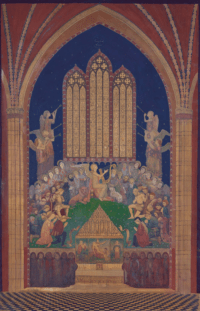Walter CRANE
Walter Crane (born August 15, 1845, in Liverpool; died March 14, 1915, in Horsham, West Sussex) was a prominent English painter and illustrator and a leading figure in the Arts and Crafts Movement. As the third child of portrait painter Thomas Crane, Crane grew up immersed in the arts. Following his father’s death in 1859, he apprenticed under the wood engraver William James Linton in London, where he drew inspiration from renowned artists like Dante Gabriel Rossetti and John Everett Millais. He also attended drawing classes at Heatherly’s School of Art during his artistic development.
In 1880, Crane began serving as the artistic director of the London Decorating Company, designing tiles and glassware. In 1888, he played a key role in founding the Art and Crafts Exhibition Society and became its first president. This society aimed to revive craftsmanship as an artistic practice, supporting artists such as William Morris and Edward Burne-Jones. Crane was also highly regarded as an illustrator, especially for children’s books, including Oscar Wilde’s “The Happy Prince and Other Tales.”
Crane was a strong advocate for art education, teaching at the Manchester School of Art and later at the Royal College of Art. His notable works include “The Fate of Proserpine” and “The Birth of Venus,” and his art was widely appreciated in Europe, particularly in Germany and Austria. He illustrated classics such as Shakespeare’s The Tempest and works by Edmund Spenser, furthering his influence on the Art Nouveau movement in Germany. His works were exhibited internationally, including in Munich and Vienna, contributing significantly to the spread of the Arts and Crafts Movement.
After a trip to America in 1891, he created illustrations for Nathaniel Hawthorne’s Wonderbook for Boys and Girls and other American publications. In his later years, he organized the British contribution to the Turin Exhibition of Decorative Art, for which he was honored by King Victor Emmanuel.
Showing the single result
-
Heavenly Glory (1885) | Tempera-Aquarell (Mischtechnik) von Walter CRANE
Walter CRANE (1845-1915)

